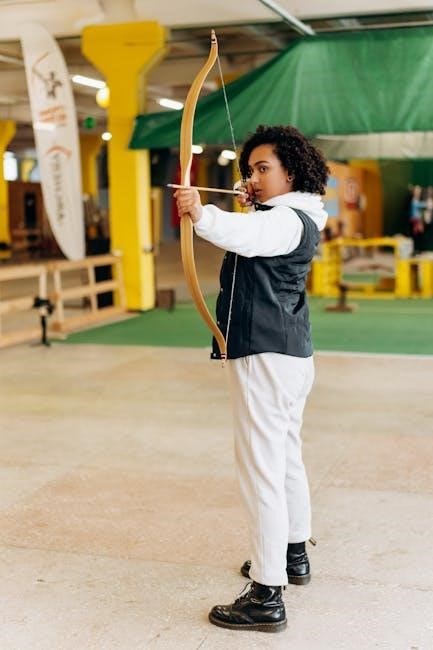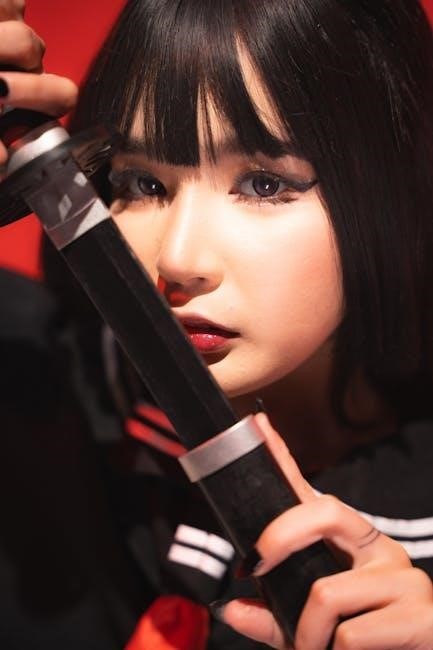
maxine hong kingston woman warrior pdf
The Woman Warrior: Memoirs of a Girlhood Among Ghosts by Maxine Hong Kingston is a groundbreaking memoir blending personal stories‚ mythology‚ and cultural exploration. Published in 1976‚ it reflects Kingston’s journey to reconcile her Chinese heritage with her American identity‚ offering a powerful exploration of identity‚ gender‚ and belonging.
1.1 Overview of the Book
The Woman Warrior: Memoirs of a Girlhood Among Ghosts is a collection of interconnected stories that blend memoir‚ mythology‚ and cultural history. Divided into five self-contained chapters‚ the book explores the struggles of Chinese-American women‚ weaving together personal narratives‚ family legends‚ and mythological tales. Kingston examines themes of identity‚ gender‚ and cultural belonging‚ offering a unique perspective on the experiences of women across generations.
1.2 Historical Context and Publication Details
The Woman Warrior: Memoirs of a Girlhood Among Ghosts was published in 1976 by Alfred A. Knopf. The memoir is set against the backdrop of Kingston’s childhood in Northern California during the 1940s and 1950s‚ a period marked by post-World War II societal changes. Her mother’s experiences escaping Japanese bombing in Canton during the 1930s further enrich the historical tapestry‚ blending personal and cultural narratives to explore identity and resilience.

Author Background: Maxine Hong Kingston
Maxine Hong Kingston is a renowned Chinese-American author known for blending memoirs with mythology‚ exploring themes of identity and cultural heritage in her works.
2;1 Biography and Cultural Heritage
Maxine Hong Kingston‚ born on October 27‚ 1940‚ in Stockton‚ California‚ is a first-generation Chinese American. Her parents‚ immigrants from China‚ instilled in her a deep connection to Chinese traditions and storytelling. Kingston’s cultural duality shaped her writing‚ blending Chinese folklore with American experiences‚ as seen in The Woman Warrior‚ which reflects her heritage and identity struggles.

2.2 Personal Struggles and Writing Style
Maxine Hong Kingston’s personal struggles with identity and cultural dislocation deeply influenced her writing. She faced challenges reconciling her Chinese heritage with American life‚ reflected in her lyrical yet fragmented prose. Kingston’s unique style blends memoir‚ myth‚ and poetry‚ creating a non-linear narrative that mirrors her internal conflicts. Her work challenges traditional genres‚ giving voice to silenced stories and exploring themes of identity‚ gender‚ and cultural displacement with profound emotional resonance.

Cultural and Historical Context
The Woman Warrior reflects Kingston’s family history and cultural heritage‚ blending Chinese traditions with American experiences. It explores historical events like WWII and migration‚ shaping her narrative.
3.1 Chinese Heritage and American Experience

Maxine Hong Kingston’s work intricately weaves her Chinese heritage with her American experience‚ reflecting her dual identity. Her Chinese roots are explored through talk-stories and myths‚ while her American upbringing shapes her sense of self. The memoir highlights the tension between traditional Chinese values and modern American life‚ creating a unique narrative of cultural blending and personal identity. This duality is central to Kingston’s exploration of belonging and cultural hybridity.
3.2 The Impact of War and Migration
War and migration deeply influenced Maxine Hong Kingston’s narrative‚ as her mother escaped Japanese bombing in China during the 1930s. This historical turmoil shaped her family’s journey to America‚ blending stories of resilience with cultural displacement. Kingston’s work reflects the emotional and societal challenges of migration‚ linking her personal identity to the broader experiences of dislocation and adaptation faced by her family and community.

Themes and Symbolism
The Woman Warrior explores themes of identity‚ cultural heritage‚ and gender oppression. Kingston uses storytelling as a symbol of resistance and empowerment‚ blending myth and reality to articulate silenced voices.
4.1 Identity and Belonging
Maxine Hong Kingston’s The Woman Warrior delves into the struggle of reconciling Chinese heritage with American identity. Kingston‚ as a first-generation Chinese American‚ grapples with cultural disconnection and self-discovery. Through her mother’s “talk-stories” and mythical figures like Fa Mu Lan‚ she explores the tension between her dual identities. The memoir reflects her journey to find belonging‚ navigating the expectations of her family and the realities of her American upbringing‚ ultimately defining her own sense of self. Kingston’s narrative becomes a powerful exploration of cultural identity and the search for belonging in a hybrid world.
4.2 Gender Roles and Oppression
The Woman Warrior critically examines the oppressive gender roles imposed on women‚ both in Chinese culture and American society. Kingston’s narratives‚ such as her aunt’s tragic story and her own defiance through the figure of Fa Mu Lan‚ challenge traditional expectations of women as submissive. The memoir highlights the silencing of women’s voices and the limitations placed on their autonomy‚ offering a feminist critique of these oppressive systems and celebrating female resilience and resistance.
4.3 The Power of Storytelling
The Woman Warrior emphasizes storytelling as a vital tool for preserving cultural heritage and personal identity. Kingston’s “talk-stories” bridge her Chinese roots and American experience‚ allowing her to explore complex emotions and reclaim silenced voices. Through myth‚ family history‚ and personal narrative‚ storytelling becomes a means of empowerment‚ enabling Kingston to navigate her dual identity and challenge cultural norms while connecting with her ancestors and community.

Personal Identity in the Memoir
Kingston’s memoir explores her journey of self-discovery‚ navigating the blend of Chinese heritage and American culture‚ while confronting internal conflicts and societal expectations to find her voice and belonging.
5.1 Kingston’s Journey of Self-Discovery
Maxine Hong Kingston’s memoir traces her complex journey of self-discovery‚ navigating the intersection of Chinese heritage and American identity. Through storytelling‚ she confronts internalized conflicts‚ societal expectations‚ and cultural silences. Kingston’s exploration of her aunt’s tragic fate‚ her mother’s resilience‚ and the mythical figure of Fa Mu Lan empowers her to reclaim her voice and define her place between two worlds‚ ultimately finding a sense of belonging and empowerment.
5.2 Family and Cultural Dynamics
Maxine Hong Kingston’s memoir delves into the intricate dynamics of her family and cultural heritage. Her mother’s “talk-stories” reveal the silenced histories of women like her aunt‚ while her father’s stoicism reflects traditional Chinese values. Kingston’s experiences highlight the tension between generational expectations and personal aspirations‚ as she navigates the cultural gap between her parents’ traditions and her American upbringing‚ ultimately finding strength in the power of storytelling to bridge these divides.
Book Structure and Key Chapters
The Woman Warrior is divided into five self-contained chapters‚ blending memoir and myth. Each chapter explores distinct themes‚ such as the story of Kingston’s aunt and the warrior woman Fa Mu Lan‚ creating a rich narrative tapestry.
6.1 Episodic Structure and Chapter Analysis

The Woman Warrior is structured episodically‚ with five chapters that blend myth‚ memory‚ and personal narrative. Each chapter focuses on a distinct story or theme‚ such as Kingston’s aunt’s tragic fate in “No Name Woman” and her mother’s “talk-story” of Fa Mu Lan in “White Tigers.” This non-linear structure mirrors Kingston’s fragmented identity‚ weaving together Chinese folklore and American experiences to explore cultural dislocation and self-discovery.
6.2 The Role of Talk-Stories
Talk-stories are central to The Woman Warrior‚ serving as a bridge between Kingston’s Chinese heritage and her American experience. These oral narratives‚ passed down by her mother‚ blend myth‚ history‚ and personal memory. They provide moral guidance‚ cultural context‚ and a connection to her roots‚ while also enabling Kingston to explore her identity and challenge traditional gender roles; The talk-stories become a powerful tool for self-discovery and storytelling.
Literary Devices and Style
The Woman Warrior blends memoir and myth‚ creating a unique narrative style. Kingston employs non-linear storytelling‚ weaving personal experiences with cultural legends to explore identity and heritage.
7.1 Blending of Memoir and Myth
The Woman Warrior masterfully combines personal memoir with Chinese mythology and folklore. Kingston interweaves her mother’s “talk-stories” with mythical figures like Fa Mu Lan‚ creating a rich‚ layered narrative. This blend allows Kingston to explore themes of identity‚ cultural heritage‚ and gender roles‚ while bridging the gap between her American upbringing and Chinese traditions. The result is a unique storytelling style that transcends traditional memoir formats.
7.2 Use of Non-Linear Narrative
The Woman Warrior employs a non-linear narrative structure‚ blending past and present‚ myth and reality. Kingston jumps between her childhood in California‚ her mother’s stories of China‚ and mythical tales like Fa Mu Lan’s journey. This non-chronological approach reflects the fragmented nature of memory and identity‚ allowing Kingston to explore themes of cultural dislocation and self-discovery in a fluid‚ interconnected manner.
Impact on Asian-American Literature
The Woman Warrior is a landmark work in Asian-American literature‚ offering a powerful voice to the experiences of Chinese-American women through its unique blend of memoir and myth‚ inspiring future writers.
8.1 Contribution to Feminist Literature
The Woman Warrior has become a cornerstone of feminist literature‚ offering a powerful exploration of women’s oppression and resilience. Kingston challenges traditional gender roles by recounting stories of women like her aunt and the mythical Fa Mu Lan‚ who defy societal expectations. The book gives voice to silenced women‚ blending personal narrative with myth to critique patriarchal norms and celebrate female strength‚ reshaping feminist discourse in Asian-American communities.
8.2 Influence on Subsequent Writers
The Woman Warrior has profoundly influenced Asian-American literature‚ inspiring future writers to explore identity and cultural duality. Kingston’s innovative blending of memoir and myth paved the way for experimental storytelling‚ encouraging authors to push boundaries in narrative form. Her work has empowered writers like Amy Tan and Celeste Ng to explore themes of cultural identity and family history‚ cementing her legacy as a trailblazer in the literary landscape.

Reception and Criticism
The Woman Warrior received widespread critical acclaim for its innovative storytelling and feminist themes‚ earning Kingston significant recognition. However‚ some critics argued it misrepresented Chinese culture‚ sparking debate over cultural authenticity and its portrayal of traditional values‚ reflecting the complex reception of this landmark work.
9.1 Critical Acclaim and Recognition
The Woman Warrior garnered widespread critical acclaim for its innovative blend of memoir and myth‚ earning Maxine Hong Kingston significant recognition. Praised for its lyrical prose and deep exploration of identity‚ the book is celebrated as a landmark in Asian-American and feminist literature. It has received numerous awards and is widely studied in academic circles‚ solidifying its place as a groundbreaking work in contemporary American writing.
9.2 Controversies and Cultural Critique
Despite its acclaim‚ The Woman Warrior faced criticism for its portrayal of Chinese culture and traditions. Some argued that Maxine Hong Kingston’s blending of myth and reality misrepresented cultural practices‚ sparking debates about authenticity. Critics accused her of perpetuating stereotypes‚ while others defended her unique storytelling as a powerful feminist and cultural commentary. The book remains a divisive yet impactful work in literary discussions about identity and representation.
Guide to Reading the PDF Version
Reading the PDF version of The Woman Warrior offers a convenient way to engage with Kingston’s vivid storytelling and cultural insights. Focus on key passages‚ themes‚ and literary devices to deepen your understanding. The digital format allows easy navigation and note-taking‚ enhancing your analysis of this seminal work in Asian-American literature.
10.1 Tips for Analyzing the Text
When analyzing The Woman Warrior PDF‚ focus on key themes like identity‚ culture‚ and gender. Highlight passages that blend memoir with myth‚ such as Fa Mu Lan’s story. Pay attention to Kingston’s non-linear narrative and symbolic language. Note how she uses talk-stories to explore family dynamics. Make annotations on motifs like silence‚ shame‚ and resilience. Research historical and cultural references to deepen your understanding. Reflect on how Kingston’s experiences mirror broader societal issues.
10.2 Key Passages to Focus On

Focus on the story of Kingston’s aunt‚ No-Name Woman‚ which explores themes of identity and cultural conflict. Analyze the talk-story of Fa Mu Lan‚ a mythical warrior‚ and Kingston’s imaginative identification with her. Examine the chapter about Kingston’s mother‚ Brave Orchid‚ and her role in shaping Kingston’s understanding of identity. Pay attention to the chapter where Kingston imagines herself as Fa Mu Lan‚ defying societal expectations. Highlight the passage about Moon Orchid and her struggles in America. Note the symbolic use of ghosts and silence throughout the text.
The Woman Warrior remains a seminal work in Asian-American literature‚ offering profound insights into identity‚ culture‚ and resilience‚ leaving a lasting legacy in feminist and cultural discourse.
11.1 Legacy of “The Woman Warrior”
The Woman Warrior stands as a groundbreaking work in Asian-American literature‚ blending myth and memoir to explore identity and culture. Its innovative storytelling has inspired countless writers‚ solidifying Kingston’s role as a pioneer in feminist and multicultural narratives. The book’s enduring relevance continues to resonate‚ making it a cornerstone of academic and cultural studies‚ while its influence extends beyond literature‚ shaping broader conversations on identity and belonging.
11.2 Final Thoughts on Its Significance
The Woman Warrior remains a seminal work in Asian-American literature‚ offering profound insights into identity‚ gender‚ and cultural heritage. Its unique blend of memoir and myth has redefined storytelling‚ inspiring future writers to explore hybrid narratives. Kingston’s work not only challenges cultural silences but also fosters empathy and understanding‚ cementing its place as a timeless exploration of resilience‚ self-discovery‚ and the universal human experience.